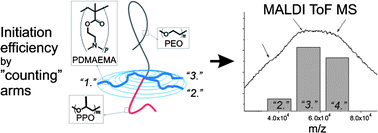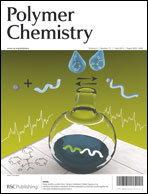The preparation of miktoarm stars, based on poly(ethylene oxide) (PEO), poly(N,N-dimethylaminoethyl methacrylate) (PDMAEMA) and either poly(propylene oxide) (PPO) or poly(ethyl glycidyl ether) (PEGE), is described. Hereby, partly protected dipentaerythritol (dipentaerythritoldiacetonide) is used as a bifunctional alcohol in a polymer-based Williamson ether synthesis to become the core of the star. Mesylated PEO is reacted first with excess dipentaerythritoldiketal. This ensures full modification of the PEO with one telechelic dipentaerythritol moiety. This telechelic PEO with one hydroxyl function is then converted to a diblock copolymer with the dipentaerythritol unit at the junction point between the blocks. To achieve this, two pathways have been developed: (a) by reaction with ready-prepared, mesylated PPO and (b) by ring-opening, anionic polymerization of ethyl glycidyl ether, leading to a narrow dispersed block copolymer. The advantages and disadvantages of both routes are discussed, though both provide perfect scaffolds for further polymer grafting. This is achieved by mild deprotection of both diblocks in order to yield 4 hydroxyl functions at the core of the future star. After attachment of an initiator, atom transfer radical polymerization (ATRP) is used to grow up to 4 arms of PDMAEMA from the center of each diblock copolymer. Thus, (PEO)–(PDMAEMA)k–(PPO) or (PEO)–(PDMAEMA)k–(PEGE) heteroarm stars are prepared by a combined “arm-first” and “core-first” method. The molecular characterization is accompanied by NMR, size exclusion chromatography (SEC), osmometry and matrix-assisted laser desorption/ionization time-of-flight mass spectrometry (MALDI ToF MS). The latter method even allows an estimation of the initiation site efficiency during ATRP. In turn, the final molecular formula of the stars can be derived. We illustrate that a decreased initiation site efficiency generates a specific footprint in the molecular weight distribution, which could be partly reproduced by MALDI ToF MS. By comparing the simulated spectra with the real ones, one can draw conclusions on the initiation site efficiency. The obtained initiation site efficiency is found to be comparable to the one obtained by the standard destructive method: determination of molecular weight of cleaved arms, which is tedious and polymer-consuming. Therefore, it is anticipated that both the synthetic procedures as well as the analytics can be easily adapted to other polymers.


 Please wait while we load your content...
Please wait while we load your content...